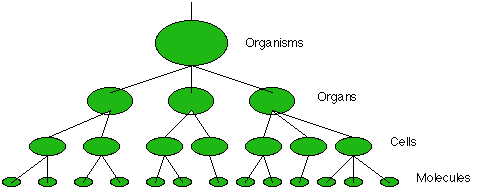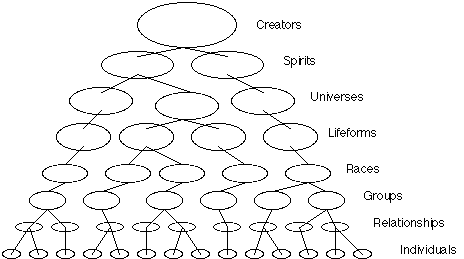
Holarchy is a word coined as a combination between the Greek word 'holos' meaning whole and the word 'hierarchy'. Here is an example of a Holarchy, taken from biology:

It is a structure of units or entities called Holons. Each Holon could be regarded as either a whole or as a part depending on how one looks at it. A Holon will look as a whole to those parts beneath it in the hierarchy, but it will look as a part to the wholes above it.
This dualism is a key concept in this universe. Just about anything you would choose to study could be regarded as either an independent whole or as a part of something bigger. A lot of interesting and puzzling phenomena come out of this. It creates dichotomies of independence versus integration, individuation versus unity, competition versus cooperation, cause versus effect, etc.
Neither of the two extremes provides a complete theory for understanding life. We can't just say that everything is separate and doesn't depend on anything else. We can't say either that everything is being controlled by something else. Seems that we have to juggle the apparent self-contradiction of everything being both cause and effect depending on how you look at it.
What becomes interesting for the purpose of processing is to see how beings fit into this picture. Some systems of thought regard a spiritual being as a totally independent, self-determined unit that can be full cause. But that makes it a bit puzzling to figure out how such a being gets into trouble and how she interacts with other beings who are also fully independent. It might be more satisfactory to adopt some of the Holarchy/Holon model.
This becomes more clear if we draw a Holarchy of domains of life:

One person observed as an individual can be fully self-controlled. She can basically think and do whatever she wants. We can regard one individual as a whole. But that person probably has some close interaction with people around her, she probably has family and friends. We find that the individual as a part of some relationship is not just determined by her own self-interest. She will cooperate with the other individuals and might work at doing what is best for them as a whole. And when we look at a group we find that individuals and particular relationships become even more sub-ordinate. If you are working for a company you have to be there on time, do certain things that somebody else assigns to you and so forth. If you do that well and you cooperate with the other members of the group it allows the group to function as a whole. But that is not the end of it. The group will engage in competition with other groups. But if we go one step up we find that all the groups belong to the same overall race of people. Maybe they will cooperate for the good of mankind and the race can become a whole. And so forth.
The higher we go in the holarchy the more freedom and the more overall range of activity can be observed. If you command a universe there is so much more you can do than if you just move one individual human being around. But then again, a universe is just part of something bigger that it is sub-ordinate to.
We could say that the higher we go the closer we get to a statement of the true basic nature of things. It is much more true to say that the real You is Everything than to say that you are just one little human being. We could possibly say that there is an absolute, infinite top of the scale, All-that-is, that isn't part of anything else. But any other concept, beingness, or grouping of any kind is inherently both a part and a whole.
A single person we sit down to get a session is obviously not all there is. There are other people and other stuff around that the person is sub-ordinated to to some degree. But we can still treat the person as a whole and work with the stuff that is sub-ordinated to her.
The processing we do with an individual is to a large degree involved with sorting out the relationships between different parts of her. Parts of her have become independent units that might be in all sorts of conflicts with each other. From the perspective of the individual that is not very desirable. What we would therefore do is to locate those conflicting parts and to bring them into alignment with each other. We would thereby establish more integration. That is, we would make the individual a more integrated person, more wholly herself and not as fragmented.
It becomes obvious that we can optimize a certain whole by re-aligning its parts. And just as obvious that if we want to handle higher level wholes we would move up in the holarchy. We can make one individual more integrated by working with her parts. But if we want to make the group she is part of work better, then we need to move up further. We would have to get the actual group into session, not just one of its parts, one individual.
A Holon is a node in a Holarchy. A Holon looks up for what it needs to cooperate with and integrate with. It looks sideways for what it needs to compete with. It looks down for what it needs to command. Each holon can not be fully explained by or predicted by a study of its parts. It is something more. A Holon is also part of something bigger. But at the same time it has a high degree of autonomy, it has a life of its own.
To sort out a conflict between Holons one needs to take a step up to the next higher whole and to establish more integration and cooperation among its parts. For example, to sort out a conflict between two people we can't resolve it just by looking into their individual minds. But if we take a step up and examine what kind of relationship they have, or what kind of group they are both part of we can then work to establish cooperation.
Likewise, if several parts of a person are in conflict with each other we don't get much resolution from examining just those parts in themselves. We need to take a step up and examine what the whole person is about. Only then can we align the parts with the whole and make them more integrated.
Now, life isn't really a nicely organized hierarchy. A clean model is a useful tool to work with in making sense out of things. However reality consist just as much of cross-associations. Parts of wholes might associate with parts of other wholes, thereby creating new wholes that can again be split into parts, and so forth ad infinitum. That is what makes life a challenging puzzle. But the tool of looking at one holarchy or one holon at a time is valuable in figuring things out. Each Holon can be considered an integral entity. It connects upwards towards bigger wholes and downwards towards smaller parts.
No man is an island. He is a Holon.